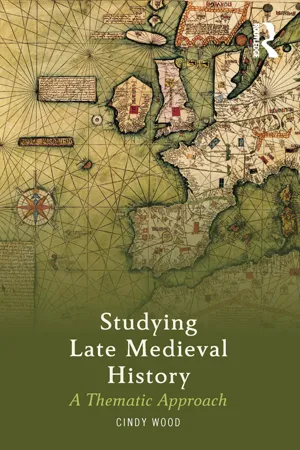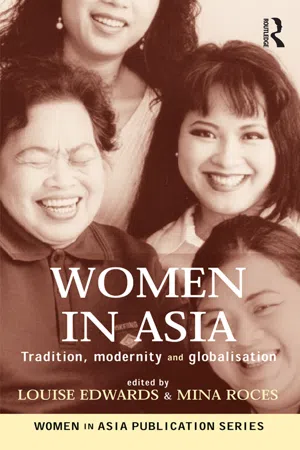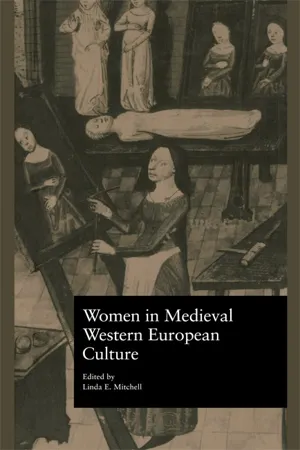History
Women In Medieval India
Women in Medieval India played diverse roles in society, including as rulers, administrators, scholars, and artists. While some women faced restrictions due to societal norms, others enjoyed significant freedom and influence. The status and rights of women varied across regions and time periods, reflecting the complex and dynamic nature of gender dynamics in medieval Indian society.
Written by Perlego with AI-assistance
Related key terms
3 Key excerpts on "Women In Medieval India"
- eBook - ePub
Studying Late Medieval History
A Thematic Approach
- Cindy Wood(Author)
- 2016(Publication Date)
- Routledge(Publisher)
5 Women in medieval Europe DOI: 10.4324/9781315618524-5Traditionally the writing of narratives of elite males, and political and ecclesiastical history have dominated history, especially in the nineteenth century. The development of ‘history from below’ and gender studies since the Second World War and especially the 1960s has moved on from this position. Gender studies and especially the history of women is now a respected area of academic research, but it is a contentious issue in gender studies that women are treated as ‘separate’, when in fact their lives were always intrinsic to life in general. Although women and men did live in the same society this chapter will look at the experience of women and their lives in different contexts, while acknowledging that these were often within a male dominated society. Whereas women may not have had much overt power in this period, they were not always powerless.Women in the medieval period were in many ways very similar to those of today, acting as mothers, sisters, daughters and often lovers. It was the conventions of the time that dictated how these relationships evolved, developed and operated. Society and its rules were different from ours, and women’s experiences need to be seen in this context, rather than judged in comparison to today’s society. Women of all types lived with men, even those who chose to live a secluded, religious life away from society, as men were needed to act as their priests to perform Mass. This activity was barred (and still is) for women in the Roman Catholic Church. Women as wives, daughters, widows or nuns also required men to administer their lands, provide legal support and act as overseers. In general terms if men of this period could be categorised (VERY roughly) as monks, knights or peasants, then women could be categorised as wives, mothers or virgins (that is those who dedicated their lives to the Church). - eBook - ePub
Women in Asia
Tradition, modernity and globalisation
- Louise Edwards, Mina Roces(Authors)
- 2020(Publication Date)
- Routledge(Publisher)
5Diversity and the status of women: the Indian experienceRuchira Ganguly-ScraseSchool of Humanities and Social SciencesCharles Sturt University ‘The secondary status of woman is a pan-cultural fact’…So argued Sherry Ortner in 1970 in her now famous essay, ‘Is female to male as nature is to culture?’ At the end of the twentieth century it is impossible to universalise the subordination of the world’s women in such a fashion, let alone homogenise the mass of Indian women. Grappling with diversity and difference is central to understanding the position of women in India. Since the heydays of the women’s liberation movement in the 1970s, when there was a sense of women’s solidarity and sisterhood, feminist theorists have shifted their attention to the study of difference among women. Scholarly analysis used to focus on women’s shared oppression and male domination, but more recent research has shown that male domination and female subordination is far from uniform. On the contrary, women’s experiences are distinguished by their specific locations within particular ethnic, class and religious groupings.Thus, no unitary categorisation of Indian women is possible. For example, in India over the past two decades the achievements of urban middle-class women in salaried and professional jobs have been as spectacular as the relentless exploitation and acute deprivation of female agricultural labourers (Bardhan 1993). There are many powerful and influential Indian women in the professions, business, bureaucracy and government who enjoy the privileges and benefits of their class position. Such women have also gained from the anti-colonial straggles of the Indian nationalist movement, which gave them a voice in the political arena. After independence from British colonial rule in 1947 these women had relatively easy access to the expanding civil service as well as representation in parliament. However, the vast majority of women in India do not belong to this affluent middle class. Their lives are constrained by problems typical of a post-colonial developing economy. - eBook - ePub
- Linda E. Mitchell(Author)
- 2012(Publication Date)
- Routledge(Publisher)
15 Historians may also have overestimated women's influence in the family-based political units, the clan. At Ghent the blood-price, the zoen, went to the male members of the clan, not to the widow or immediate family members, as compensation for the male members of the clan losing one of their own. From medieval Florence we have a few documents listing various clan agreements. Women form no part of them, either in the deliberations or in the execution of the documents. Lastly, this thesis never answers the crucial questions: Why had women been excluded from urban politics before the Late Middle Ages? What was it about their participation that men feared?An obvious reason as to why women were excluded from urban politics is also the main reason why women had limited public roles in medieval (as well as ancient and Early Modern) society as a whole: the dichotomy between public and private life, one organized by and for men, the other for women. That was a simple fact of premodern life. Travel was difficult for women, who were bound to the domestic sphere through their marital and maternal obligations. Women were responsible for most of the domestic duties and hence had little time for public activity—or at least less than men had. In fact, the private work of women, including especially that of serving women, actually facilitated the public role of men. One of the things, therefore, that made women ineligible for politics in a medieval city from early on (and seemed so to the men who ran the towns) was the demands on their time and energy by the private sphere, a structure of their daily life.
Index pages curate the most relevant extracts from our library of academic textbooks. They’ve been created using an in-house natural language model (NLM), each adding context and meaning to key research topics.


